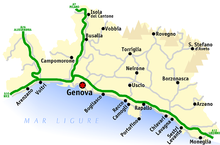
Liguria is a region of north-western Italy; its capital is Genoa. Its territory is crossed by the Alps and the Apennines mountain range and is roughly coextensive with the former territory of the Republic of Genoa. Liguria is bordered by France to the west, Piedmont to the north, and Emilia-Romagna and Tuscany to the east. It rests on the Ligurian Sea, and has a population of 1,557,533. The region is part of the Alps–Mediterranean Euroregion.

The Republic of Genoa was a medieval and early modern maritime republic from the years 1099 to 1797 in Liguria on the northwestern Italian coast. During the Late Middle Ages, it was a major commercial power in both the Mediterranean Sea and the Black Sea. Between the 16th and 17th centuries, it was one of the major financial centers in Europe.

The province of Asti is a province in the Piedmont region of Italy. Its capital is the city of Asti. To the northwest it borders on the Metropolitan City of Turin; to the southwest it borders on the province of Cuneo. To the east it borders on the province of Alessandria, while in the south it shares a very short border with the Ligurian province of Savona. It has an area of 1,504.5 square kilometres (580.9 sq mi), and, As of 2017, a total population of 215,871.
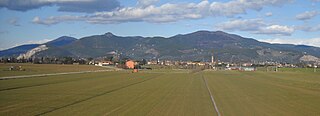
The province of Pisa is a province in the Tuscany region of Italy. Its capital is the city of Pisa. With an area of 2,448 square kilometres (945 sq mi) and a total population of 421,642, it is the second most populous and fifth largest province of Tuscany. It is subdivided into 37 comuni.

Finale Ligure is a comune on the Gulf of Genoa, in the province of Savona, in Liguria, Italy. It is considered part of the Italian Riviera. Part of its historical center ("Finalborgo") is one of I Borghi più belli d'Italia.

Arenzano is a coastal town and comune in the Metropolitan City of Genoa, Liguria, northern Italy, facing the Ligurian Sea. As of 2017, it has a population of 11,445. This varies during the holiday seasons due to tourist flow.

San Biagio della Cima is a comune (municipality) in the Province of Imperia in the Italian region Liguria, located about 120 kilometres (75 mi) southwest of Genoa and about 30 kilometres (19 mi) west of Imperia.
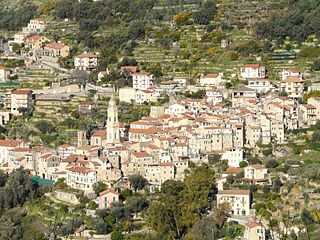
Vallebona is a comune (municipality) in the Province of Imperia in the Italian region Liguria, located about 120 kilometres (75 mi) southwest of Genoa and about 30 kilometres (19 mi) west of Imperia. Vallebona borders the following municipalities: Bordighera, Ospedaletti, Perinaldo, San Biagio della Cima, Seborga, Soldano, and Vallecrosia.

Vallecrosia is a comune (municipality) in the Province of Imperia in the Italian region Liguria, located about 120 kilometres (75 mi) southwest of Genoa and about 30 kilometres (19 mi) west of Imperia. It is next to the busy city of Ventimiglia.

Sassello is a comune (municipality) in the Province of Savona in the Italian region Liguria, located about 58 kilometres (36 mi) west of Genoa and about 26 kilometres (16 mi) north of Savona in the northern side of the Ligurian Apennines. It is the birthplace of Blessed Chiara Badano.
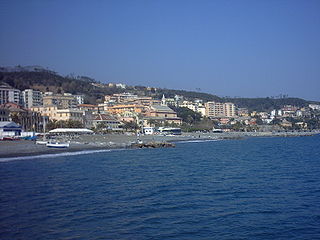
Cogoleto is a comune (municipality) in the Metropolitan City of Genoa in the Italian region Liguria, located about 25 kilometres (16 mi) west of Genova. Its territory extends from the sea to the Ligurian Apennines; it is part of the Natural Regional Park of Monte Beigua.

Moconesi is a municipality (comune) in the Metropolitan City of Genoa in the Italian region Liguria. The head-hamlet of Moconesi municipality is the village of Ferrada which is located about 40 kilometres (25 mi) northeast of Genoa and 1 kilometre (0.6 mi) from the house in Terrarossa, reportedly place of birth of Christopher Columbus.

Torriglia is a comune (municipality) in the Metropolitan City of Genoa in the Italian region Liguria, located in the upper Trebbia valley, about 20 kilometres (12 mi) northeast of Genoa. Torriglia borders the following municipalities: Davagna, Lorsica, Lumarzo, Mocònesi, Montebruno, Montoggio, Neirone, Propata, Rondanina, Valbrevenna.

Boccadasse is an old mariners' village of the Italian city of Genoa. It lies within the borders of the neighbourhood of Albaro. In today's administrative subdivision it is located in the Municipio VIII - Medio Levante area which includes the neighbourhoods of Albaro, Foce, San Martino. Boccadasse is bordered on the west side by Via Felice Cavallotti, by Via Caprera on the northern side and by Via Capo di Santa Chiara on the eastern side. Naturally, it is delimited by the sea to the south.

Albaro is an affluent residential neighbourhood of the Italian city of Genoa, located 3 kilometres (1.9 mi) east of the city centre. It was formerly an independent comune, named San Francesco d'Albaro, included in the city of Genoa in 1873. At present, together with the neighbourhoods of Foce and San Martino d'Albaro is part of the Genoa's city VIII Municipio.

The Delle Piane family is an old Genoese noble family first recorded in Polcevera in 1121. Over the past ten centuries it has produced many distinguished government officials, clerics, diplomats, soldiers and patrons.
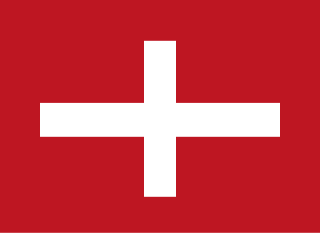
The Republic of Noli was an Italian maritime republic that was centred on the city of Noli, in Liguria, and existed from 1192 to 1797. The area is now in the province of Savona, Italy. To protect itself from possible attacks and invasions by Savona and Marquisate of Finale, Noli allied in 1202 with the Republic of Genoa in a sort of protectorate, in fact, documents of the time show that the relationship was equal and not one of submission. The alliance allowed the Republic of Noli to have such growing importance that in 1239, a diocese was established there by Pope Gregory IX.
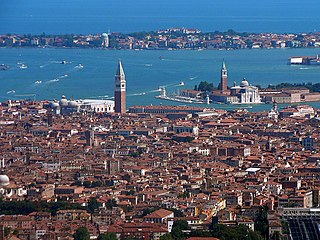
The Metropolitan City of Venice is a metropolitan city in the Veneto region of Italy, one of ten metropolitan cities in Italy. Its capital is the city of Venice. It replaced the province of Venice in 2015 and includes the city of Venice and 43 comuni. It was first created by the reform of local authorities and then established by Law 56/2014. The Metropolitan City of Venice is headed by the Metropolitan Mayor and the Metropolitan Council. Since 15 June 2015, as the new mayor of the capital city, Luigi Brugnaro is the first mayor of the metropolitan city.

Genoa is a city in and the capital of the Italian region of Liguria, and the sixth-largest city in Italy. In 2023, 558,745 people lived within the city's administrative limits. While its metropolitan area has 813,626 inhabitants, more than 1.5 million people live in the wider metropolitan area stretching along the Italian Riviera.
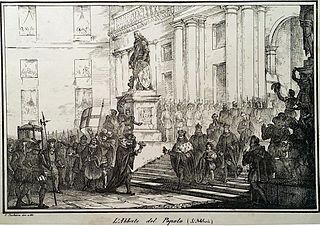
The Confeugo is an ancient cultural event in Liguria, traditionally celebrated on Christmas Eve or a couple of days before Christmas. It is a historical event linked to the Republic of Genoa and is still commemorated today mainly in Genoa and Savona, but also in other Ligurian Municipalities that were once the seat of podesterie and capitaneati.



